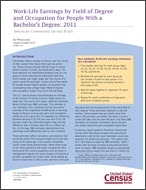Work-Life Earnings by Field of Degree and Occupation for People With a Bachelor’s Degree: 2011
Work-Life Earnings by Field of Degree and Occupation for People With a Bachelor’s Degree: 2011
Introduction
Individuals make a variety of choices over the course of their careers that impact their earning potential. These choices include how far to go in school, what to study in school, and what job to take. This brief explores the relationship between how far one goes in school (educational attainment) and how much money one might make over the course of a career (work-life earnings). It goes into further detail for people whose highest degree is a bachelor’s by investigating how college major (field of degree) and occupation impact these work-life earnings.
The U.S. Census Bureau has developed an estimate of the amount of money a person might expect to make over the course of a career called the Synthetic Work-Life Earnings (SWE) estimate. This estimate is not intended to be a prediction but an illustrative example of the magnitude of differences in earnings based on factors such as education and occupation added up over a work life. For example, the difference between earning $125,000 per year and $150,000 per year might not seem particularly large, but the difference over a 40-year work life is a million dollars. In this way, SWE estimates demonstrate how seemingly small differences add up over a lifetime.
These estimates reflect calculation assumptions that should be noted. Not everyone begins and ends their career at the same age. Some people completely switch career fields several times, while others stay in the same position at the same company for their entire work life. Some occupations such as those in management may be the result of years of working in another occupation at a lower level. Some people go back to school later in life as well, and this continued education will not necessarily be in the same field as their degree. These estimates represent a national median. Some people may earn much more than others. No estimate can predict the exact course a career will take over the next 40 years, but these SWE estimates can provide information about the general impact education and occupation might have.
A previous report based on American Community Survey (ACS) data demonstrated that educational attainment is by far the most important social characteristic for predicting earnings.1 This report uses 2011 ACS data to create the SWE estimates. Table 1 shows how earnings increase as educational attainment increases. SWE estimates based on educational attainment alone range from less than $1 million for those with the lowest education to about $4 million for those with a professional degree. The difference in work-life earnings between workers with a high school diploma and those with a college degree is about $1 million and the difference between the estimate for workers with a college degree and the estimate for those with a doctorate is another $1 million.
__________
1 Julian, Tiffany, and Robert Kominski, “Education and Synthetic Work-Life Earnings Estimates,” American Community Survey, U.S. Census Bureau, September 2011, available at <www.census.gov/library/publications/2011/acs/acs-14.html>.
Appendices
Others in Series
Publication
Publication
Publication





